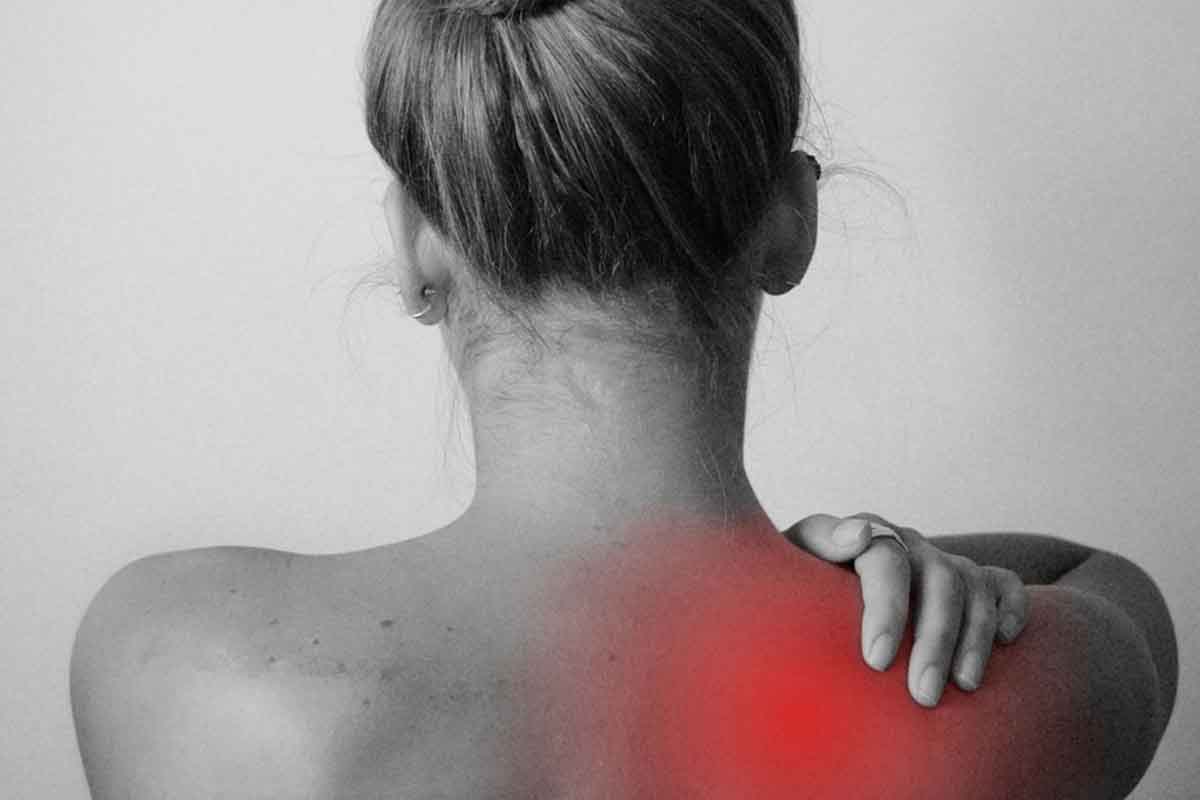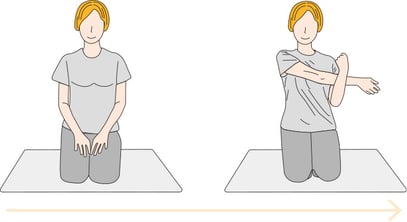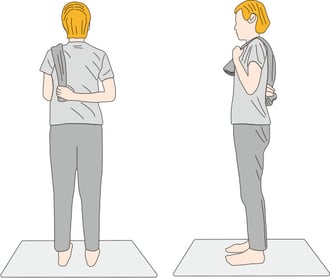
The rotator cuff consists of four muscles surrounding your shoulder blade. Each of these muscles has a tendon attaching it to your upper arm. When any of these tendons is injured, inflamed, or worn down, it may cause rotator cuff pain.
What is rotator cuff pain and how common is it?
Rotator cuff tears are among the most common orthopedic problems, affecting more than 17 million people in the US. These tears are found mainly in middle-aged and older adults. There are different types of severity including:
- Partial tear
- Full thickness tear (There are two types of full thickness tear, including:)
-
- Full-thickness incomplete tear
- Full-thickness complete tear
Trauma, such as a direct blow to the shoulder or a bad fall, can result in acute tears. Chronic overuse causes degenerative rotator cuff tendinopathy. Overwork and excessive activity might also contribute to the ailment.
When a rotator cuff tear occurs, irreversible changes of the muscle can begin within the first three months after an injury, so you should seek medical attention and take better care of yourself.
While these irreversible changes can impact your quality of life, moderate exercise and other methods can help improve your situation and manage rotator cuff pain. However, there are some exercises that are not recommended. Here’s a list of rotator cuff tear exercises to avoid:
- Bench chest press
- Shoulder press
- Lateral raise
As a cautionary tale, we would like to share the story of Cindy—a woman who was impacted by rotator cuff tears at the prime of her life:
Cindy’s Story
For anyone who works hard, bedtime is the most important part of the day. Without a good night’s sleep, your mind and body may find it hard to recharge, leaving you vulnerable to sickness and fatigue.
A hardworking woman with an incredibly hectic schedule, Cindy could only catch a break at night when it was time for her to go to bed. That changed when she began suffering from excruciating shoulder pain at night.
“Sometimes, my entire right shoulder feels hot, swollen, and painful.” Cindy shares. “I think it even affects my sense of balance whenever I walk. At bedtime, the pain makes me toss and turn. I would accidentally put pressure on my right shoulder, which quickly cuts my sleep short.”
How It All Started
The pain in Cindy’s right shoulder has been bothering her for years. Around two decades ago, Cindy was on a business trip where she worked as a courier, transporting urgent materials to and from Taiwan, Hong Kong, and the mainland.
Over the years, she got used to carrying materials weighing over 20 kgs on one shoulder. She always carried 3-4 pieces of luggage on her back and shoulders. On top of the physically demanding job, Cindy also experienced much stress catching the buses that only came twice a day.
Why It Worsened
Cindy was always too busy at her job so getting a medical checkup often felt inconvenient. Since the soreness felt in her shoulders would usually fade the next day, she elected to ignore it. However, after many years of wear and tear, the burning pain in her shoulder became too much to bear.
The Importance of Seeking Medical Attention
When she finally sought medical attention, the pain in Cindy’s shoulder worsened. So much that she couldn’t even lift her hand to brush her teeth and could barely move to dress.
After describing her medical history to the doctor in detail, Cindy was asked several follow-up questions. The doctor said, “Aside from the physical stress from your previous job, did you suffer from a fall that could’ve hurt your shoulder?”
Cindy recalled she had fallen twice during a half marathon a few years before. While she had some scratches and bruises after the fall, she was determined to finish the race, so she got up and continued running despite her injuries.
Considering her history and ultrasound, the doctor diagnosed Cindy with a rotator cuff tear. The doctor suggested that she might have sustained the injury from her fall.
- What Are Rotator Cuff Tears?
A rotator cuff is a group of muscles and tendons attached to the bones of your shoulder joint. The rotator cuff's primary job is to keep the humeral head centred in the glenoid cavity, the joint socket.
Your rotator cuff keeps your arm in your shoulder socket while moving your arms. When rotator cuff loses its function, the head of humeral bone is away from the centre of shoulder socket. The tendon or rotator cuff muscle is easily to be compressed, resulting in injury. When the tendons of the rotator cuff are injured, the tear becomes inflamed and painful.
Rotator cuff tears can occur if you fall on your arm while it is stretched out. It can also happen after a sudden, jerking motion when trying to lift something heavy.
An Important Lesson Learned
After receiving treatment, Cindy had to undergo physiotherapy and hygiene education. She was advised to rest and avoid any extraneous physical activity that involved her shoulder. However, Cindy impatiently hoped that it would not affect her business trip in 3 weeks.
Cindy forced herself to work despite her rotator cuff injury, which led to painful tearing. The burning sensation in her shoulder blade caused her heart to beat faster, and she started breaking out in cold sweat.
The painful experience taught her a valuable lesson: “more haste, less speed.” If you try to do things too quickly, it will take you longer in the end.
From then on, she followed her doctor’s advice. She never missed her hot compresses, electrotherapy, ultrasonic therapy, limb stretching exercises, and the therapist’s health education.
After more than half a year, Cindy’s condition got much better. She happily asked her doctor if she could take another ultrasound to monitor her improvement. Sadly, Cindy’s doctor delivered terrible news. Although Cindy’s condition improved, her rotator cuff tear was irreversible.
By then, Cindy realized she should stop abusing her body. Forcing yourself to perform extraneous physical activity when you need to rest is ill-advised. It is important to appreciate and cherish every cell in your body.
There are still many dreams she wants to achieve, which will only be possible with a healthy body. With an irreversible condition, Cindy needs to take utmost care of herself.
What She Could Do
Given a wake-up call, Cindy started taking better care of her body. She practised yoga, paid attention to what she eats, and sought medical help.
Within three years of practising yoga for rehabilitation, she maintained the stability of her injured right shoulder.
She was grateful for the help given by doctors, therapists, and yoga teachers during the process. Every experience has a special meaning!
Cindy stopped overexerting herself and started taking time out of her day to rest. She made her bedroom as comfortable as possible to ensure that she gets a full night’s sleep.
To ensure that she can rest as comfortably as possible, Cindy does her best to create the perfect bedroom environment. She started getting better pillows. She also installed a humidifier to keep the indoor air in her bedroom at the ideal level.

How to Relieve Rotator Cuff Pain at Night
If you are experiencing acute pain due to a rotator cuff tear, applying a cold compress on the affected area can be extremely helpful. Acute pain is defined as constant, shaper pain. You may still feel acute pain at no arm movement at all. Cold compress is a way to relieve some painful feeling.
If you start feeling chronic pain, then it is suitable to switch to hot compresses. Chronic pain is known as a sore feeling or dull aching. The shoulder pain exists in the certain motion or activity. In this condition, hot compresses is helping to soothe the tight muscles and fascia and ease the discomfort.
If you're wondering what the difference between acute pain and chronic pain is, chronic pain lasts longer than six months and can persist even after the injury or sickness has been treated. Acute pain occurs rapidly and goes away when there is no reason.
You can also try stretching exercises to soften the fascia, minimise deterioration during pulling, and strengthen adjacent muscles, protecting the wounded area and avoiding deterioration.
Relaxing the tight muscles and fascia around the affected area can help relieve discomfort. There are many ways to do this including: taking warm baths, showering with warm water, using a heating cushion on the affected area, and sleeping in an electric blanket.
Another solution to relieve rotator cuff pain is stretching. You can rehabilitate your rotator cuffs with a few stretching exercises. Crossbody shoulder stretches, shoulder internal rotation stretches, sleeper stretches, and standing rows are all effective workouts.
When muscle is tight, the muscle length is relatively short comparing to normal length. Stretching is a method to elongate the muscles and fascia. It is important to regain the normal muscle length, and let the muscles functional.
Another reason that muscle and fascia get tight is because the daily and workout use let the muscles shorten. The pain comes out at the end when the muscle and fascia can’t not bear the tightness anymore. Stretching is the main solution to deal with this pain caused by shortening. The warm compress is also a method to support the effect of stretching.
The best timing to stretch is a relaxing period after a nice and warm bath. Make yourself comfortable during your stretching time. Your mind should not be occupied by daily work or to-do-list. Try to give your shoulders a nice 15 minutes to re-breath.
These circuit movements are good for rotator cuff pain. Try the movement for 3-5 sets. Here, we assume right shoulder is the side of rotator cuff pain. The model demonstrates the movements with right arms. You can try both arms.
It is easy to see the movements are harder on the painful side. So, during to movement, you may feel slight tight, but no pain. Once you feel the pain, stop the movement immediately. In this case, the movement may not suit your condition. Skip the movement. You may need more supervision during the shoulder movements. It is recommended to seek medical help or a physical therapist.
1. Shoulder joint circular movement practice

Step 1. Kneeling on a yoga mat. Try to do a backward circle with your shoulder in a slow motion. The backward circle includes shrugging shoulders, squeezing shoulder blade and then return to the original position. Do the movement smoothly for 10 times, no need the stop at any point. It may take 2-3 seconds to finish a circle.
Kneeling on a yoga mat, or you can do this movement sitting on a stable chair. Try to do a backward circle with your shoulder in a slow motion. The backward circle includes shrugging shoulders, squeezing shoulder blade and then return to the original position. Do this backward circle in 10 times as a warm-up for the following movements. Do the movement smoothly, no need the stop at any point. It may take 2-3 seconds to finish a circle.
Notice that we only do backward circle here. There is a common poor posture called round shoulder, which is shoulders go forward. It is easy to see this poor posture in the population with rotator cuff pain. Backward circle is good for correction of this kind of posture. Therefore, you don’t need to do forward circle in case the round shoulder posture becomes more severe.
2. Posterior shoulder and deltoid stretch

Step 2. Kneeling on the yoga mat. Cross your right arm in front of your chest. Fix your right arm with left arm. Stay in this stretching position for 30 seconds. Repeat for 5 times and then switch to left side.
Same, choose a more comfortable position for yourself, either kneeling on the yoga mat or sitting on a stable chair.
Cross your right arm in front of your chest. Fix your right arm with left arm. The level of right arm goes down slight, which is more comfortable for the condition of rotator cuff pain. Now, the tightness is on lateral or posterior side of right shoulder. Stay in this stretching position for 30 seconds. Repeat for 5 times and then switch to left side.
3. Anterior shoulder and pectoral muscle stretch

Step 3. Lying on the mat on your left side. Fix your above knee with left hand. Reaching out with your right arm, looking at your right hand. Stay in the stretching position for 30 seconds. Repeat for 5 times.
Here, assume the right side is your rotator cuff pain. Attention, only do this movement for the painful side. It is not recommended to lay on the painful shoulder.
Lying on the mat on your left side. Fix your above knee with left hand. Reaching out with your right arm. You can look at your right hand for gaining more angles. Stay in the stretching position for 30 seconds. Repeat for 5 times.
4. Shoulder joint stretch with towel

Step 4. Stand on your feet equally. Put your right arm behind your back and grab a towel with your right hand. Pull the right hand with left hand in order to reach higher. Importantly, stop at the level that you feel tightness on right shoulder for 30 seconds. Repeat for 5 times.
Stand on your feet equally. Put your right arm behind your back and grab a towel with your right hand. Pull the right hand with left hand in order to reach higher. Importantly, stop at the level that you feel tightness on right shoulder for 30 seconds. Repeat for 5 times.
Haste makes waste. If you do the stretch too much, you may re-hurt your shoulder. It is effective enough to just stop at the tight level for a longer time.
5. Shoulder joint rotational movement practice

Step 5. Lie on your back on the yoga mat. Put your right arm aside your shoulder. Notice that the angles of shoulder and elbow are both 90 degrees. Spin your arm, as the axis of upper arm. Do the movement for 10 times and switch to left side.
One of the main motions that rotator cuff do is rotational movement. Therefore, it is necessary to practice rotational movement if you have rotator cuff pain.
Lie on your back on the yoga mat. Put your right arm aside your shoulder. Notice that the angles of shoulder and elbow are both 90 degrees. The way to do shoulder rotational movement is spinning your arm, as the axis of upper arm. Do the movement gently and slowly.
Try to focus on the rotational movement, rather how far your arm can go. There is no pain during the whole movement. Repeat the movement for 10 times and switch to left side.
6. Shoulder joint circular movement practice

Step 6. This step is the same as step 1. Kneeling on a yoga mat. Try to do a backward circle with your shoulder in a slow motion. Do the movement smoothly for 10 times, no need the stop at any point. It may take 2-3 seconds to finish a circle.
This movement is the same as step 1. The goal of this final step is to ease the above movement. Do this backward circle in 10 times as a cool-down of previous movements. Do the movement smoothly, no need the stop at any point. It may take 2-3 seconds to finish a circle.
When lying down to sleep, use a pillow to slightly cushion the injured shoulder. Keeping the affected area elevated can help with the pain. Aside from that, sleeping on your back is also recommended as it helps you avoid accidentally turning over and pressing on your injured shoulder. It can also help if you try looking for a more comfortable mattress or a better pillow.
Relax with Wellcare
At Wellcare, we offer a wide range of solutions to help you sleep better and keep your feet warm at all times. Our products are also equipped with the 4D Dynamic Warmth Flow system (4D DWF). Innovation in electric heating technology, the 4D DWF mimics the human body’s breathing to ensure even heat distribution throughout the surface of the product. These guarantee warmth, comfort, and safety and are made using only the finest available materials.


.png?width=512&name=united-kingdom%20(1).png)
